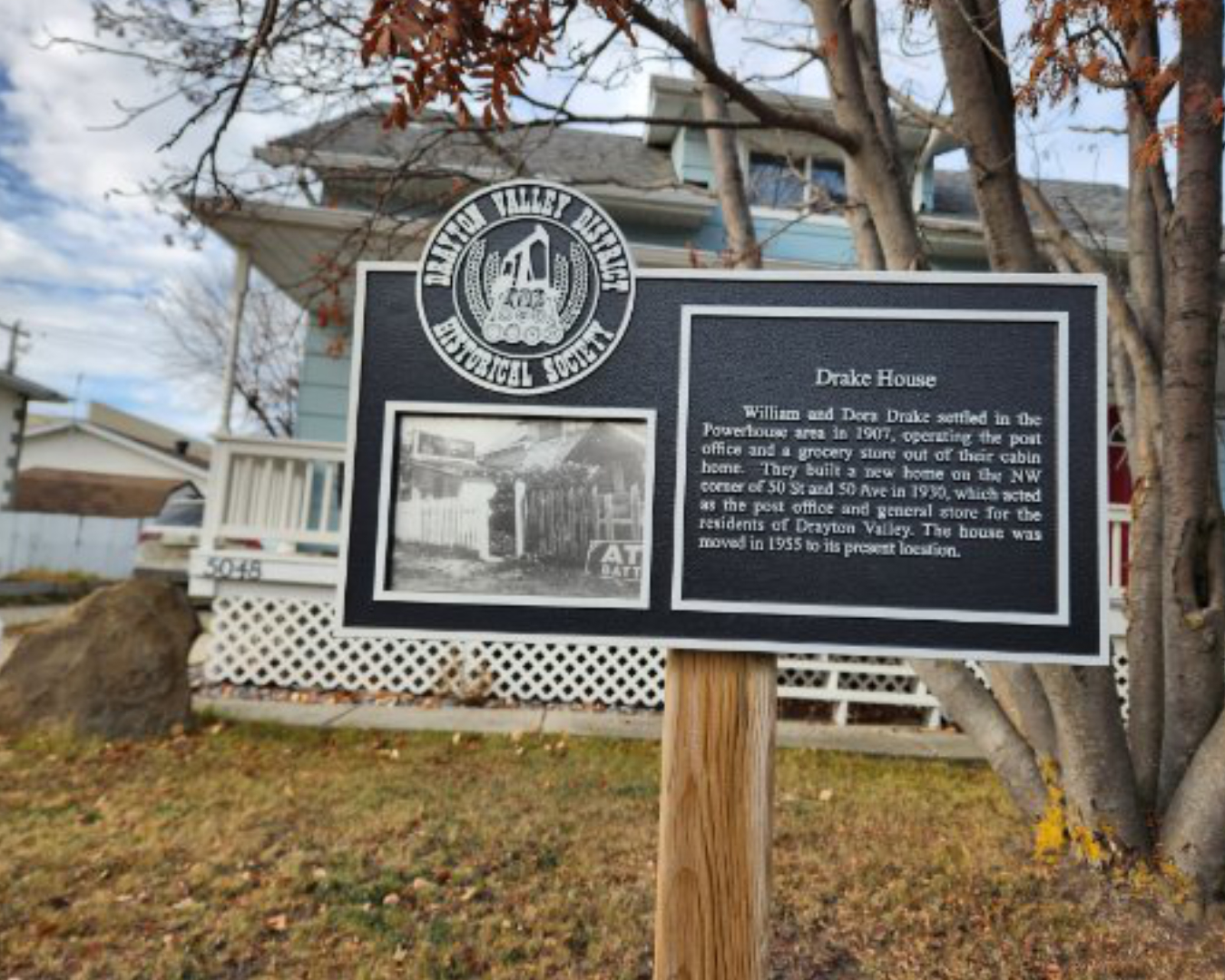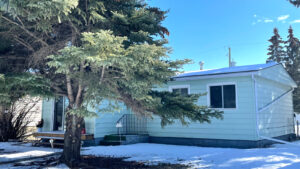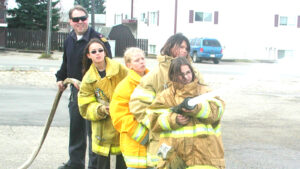A historic landmark only officially recognized in 2017 will now have a street named after it.
At the November 1 meeting, town council heard from Hans Van Klaveren, the General Manager of Community Services and Recreation, regarding a petition from a community member who asked to have 49th Street renamed as Drake Street. Council unanimously agreed to the change.
Suzanne Hommy, one of the people behind the push for the name change, says she’s happy with the decision.
Hommy’s son Brett is the current owner of the Drake house located at 5048 49 St., though he was unable to speak with the Free Press due to his work shift. Between Brett and his older brother Colton, the home has been in the hands of the Hommys for fourteen years.
Hommy and Brett were also two of the key players in getting the house recognized as one of the original homes that was built in Drayton Valley. In fact, the owners, William and Ellen (Dora) Drake, were the ones who gave the community its name.
“It took the Town a long time to recognize it and actually give us the plaque,” says Hommy.
The history of the original settlement of Drayton Valley is one that is often overshadowed by the discovery of the Pembina Oilfield, say the descendants of the Drakes who still live in the community.
“A lot of people don’t think of Drayton before the Discovery Well,” says Nicole Coleman, William and Ellen’s great-great-granddaughter, and lifetime resident of Drayton Valley.
Coleman can recall a time in elementary school when assignment was to do a family tree. “I was outright told that I was lying,” she says.
Her mother Kathy Linde and aunt Amy Newberry, say they both had similar experiences in school.
Getting the attention from the Town and County of Brazeau has been challenging for the family. For a while, it seemed the Drakes and their history had faded from the collective memory of the community.
That changed when Mandy and Tyler Layden purchased the home in the late 90s.
Layden says they very nearly passed on the home because it looked run down and strange. “I drove past it three or four months before [we purchased the house] and was like ‘Nope!’” says Layden.
That changed when she had a dream about the house. In her dream, she was walking around inside the house, and when she woke she told her husband they had to take a look inside.
“I fell in love with the bones of the place,” says Layden.
At first, Layden and her husband didn’t know anything about the history of the home. The home inspector had told them the house was built in the ‘50s, based on a permit to have a basement dug for the home in 1955. But Layden said the architecture of the place had her thinking differently.
Layden, who worked for the Town at the time, says one day she was in one of the back rooms and came across a booklet that showed older pictures of the community. Layden took a moment to look through the booklet. She came across a familiar roofline in one of the photos. She was almost certain she was seeing the same house she had, but in a different location. That lunch hour, she went home and took several polaroid pictures of her house from different angles.
“I copied the picture from the booklet for an overhead projector,” says Layden.
Once she had the copy and laid it over the picture of her home, it was an exact match. That was when Layden started digging.
She started with the development file for the lot the house sits on. She found the permit to have the house moved from 50th and 50th, where the Shale Clinic now stands, to its current location in 1955. Janet and Jean (Red) Fuhr had the home moved onto a new basement that had been dug out by horses. In 1966, the Fuhrs would sell the home to the Schubergs.
But Layden didn’t drop the trail there. She began to research everything she could find about the beginnings of Drayton Valley. By looking through history books like To Trail’s End by W.S.B. Loosmore, and Trappers, Loggers, Homesteaders and Oilmen published by the Historical Society, Layden was able to piece things together.
Layden also conducted interviews with Les Tucker, the son of Jack Tucker who took over the post office after the Drakes, Fred Kynoch, the Drake’s grandson, Eleanor Pickup, and Keith Fuhr, the son of Fuhrs that bought the house.
The story that unfurled was one Layden felt the community should know about. As she and her husband worked on renos in the house, keeping as much of the original parts as they could, she began work on talking with the Town about getting the place recognized.
But she couldn’t find anyone who wanted to recognize it. “Nobody was interested,” she says.
Layden discovered that William and Ellen Drake were amongst the first settlers in the area. At first, Ellen was alone in the area with her eight-year-old daughter, Dora (Dolly), for eighteen months. They lived in a tent while William was away working. At the time, Ellen was the only woman in the area.
When William came back, he became the Postmaster starting in 1913. He called the post office Powerhouse due to a proposed dam to be built on the North Saskatchewan River.
When William left to serve in World War I, Ellen took charge of the post in the area. But, after a call from Ottawa, Ellen learned there was already a Powerhouse in Western Canada. They asked her to come up with a new name.
Ellen chose Drayton Valley, as William had grown up in Drayton, England.
When William came back, the family eventually moved to a homestead on 50th and 50th, taking the post office with them. Some historians have said the Drake’s built the home, but the research says otherwise.
Newberry was told by her father that the ghost that is purported to haunt the house was from the man “who owned the house before the Drakes.
The home they purchased was originally built in 1928. Les Tucker, who had spoken with Layden, said he recalled the house being built “by a young man named Albert Black.” Layden also found reference in one of the books from a woman who remembers seeing the house being built in 1928 when she was going to the Eldorado School, which at the time was situated across from the house.
The Drakes purchased the home in 1930 and built a shop onto it. They operated the shop and post office until 1936. While they no longer operated the post office or the store, the Drakes lived in that house until the close of World War II. The Drakes moved to Edmonton, leaving behind their eldest daughter, Dora, who had married Gordon Kynoch.
Newberry and Linde’s father is Fred Kynoch, the son of Dora and Gordon Kynoch. They can both recall efforts that were made to try and get the home recognized.
Newberry says the original homestead was across from where Intercon Messaging now sits. She says there was a sign there at one point. But it eventually fell to the ground and though her mother tried to get the County to put it back up, it never happened.
Later, Ivy Clark, Newberry and Linde’s cousin, tried to get the Town to rename the street, but had no success.
When Layden and her husband sold the home, they were careful to choose someone who respected its history. Colton, Brett’s older brother, originally bought the home, making no changes to the house. When Brett purchased it from Colton, he decided he wanted to do some upgrades to the house, but was careful to keep as much of the original work as possible.
Hommy and her husband helped Brett with the renovations.
“We tried to keep as much as we could. We didn’t throw anything out but the old windows, but they were from the ‘80s,” says Hommy.
They restained the cupboards in the kitchen, though they were not the original cupboards, and Brett installed a dishwasher. The original threshold was kept in place, the original stairs were restained, and the old brick stove chimney that runs through the house was kept. While the Hommys changed the exterior doors, the interior doors are the same.
While Hommy’s sons lived in the house, she began speaking to the Town about having the place recognized. “I told them, ‘I’m not stopping until you give them something,’” she says.
When the plaque was put up on July 1, 2017, Hommy says she spoke to Fred Kynoch, who told her that they had tried to have the street named Drake at one point, but had no success. “So that was my next mission,” she says.
The Drakes’ family says they are very grateful for the efforts that were made on their ancestors’ behalf.
“We don’t learn about history so that it doesn’t repeat itself,” says Jodi Sandercock, Newberry’s daughter. “We learn about history because every single step that our ancestors took led us exactly to where we are standing today. Just as every step we take today impacts the steps future generations take.
“Renaming the street honours those very steps our ancestors, the Drakes, took. The Drakes created a foundation for our family to grow in this community for six generations and counting.”
Coleman agrees with Sandercock. “I would love to see some of the old settlers recognized by renaming buildings and streets,” says Coleman.
Crystal O’Malley, Newberry’s daughter, says she is excited about the change. “I think this will start a conversation and get some dialogue going.”
Linde’s daughter Melissa Linde says she’s happy there is going to be some recognition. “I think my grandpa would be really proud of all of the work that’s put into it,” she says.
“[Layden, Hommy, and Brett] did all of the legwork to make this happen, and that’s important to remember,” says Linde.
Hommy says that while she and Brett appreciate the thanks, they weren’t the only ones who made it happen. “I know they were thanking me, but there’s a whole lot of people before me. I’m just the end,” she says.
Hommy and her husband will be moving out of the country in January, and she is hoping to see the sign go up before then. Brett is also looking to sell the home in the near future, but both of them feel the Drake House’s tale is far from over.
“This story isn’t about the street, or even the family,” says Hommy. “It’s about this house and all of the people who have lived in it.”
Lorem ipsum dolor sit amet, consectetur adipiscing elit. Ut elit tellus, luctus nec ullamcorper mattis, pulvinar dapibus leo.
Lorem ipsum dolor sit amet, consectetur adipiscing elit. Ut elit tellus, luctus nec ullamcorper mattis, pulvinar dapibus leo.
Lorem ipsum dolor sit amet, consectetur adipiscing elit. Ut elit tellus, luctus nec ullamcorper mattis, pulvinar dapibus leo.
















